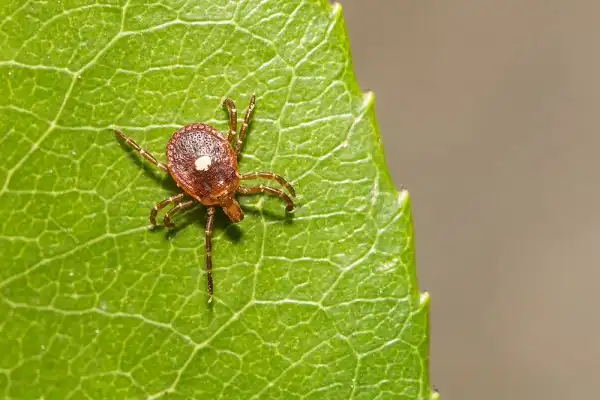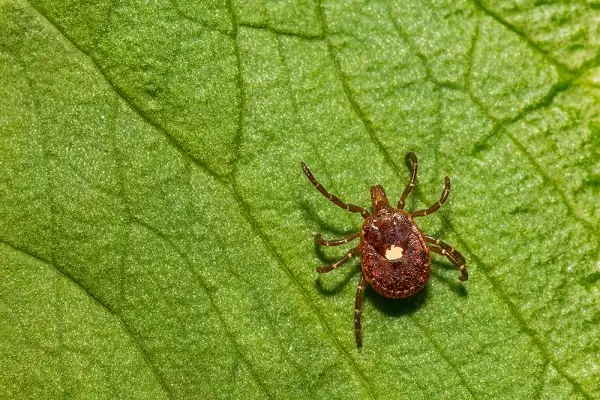There’s a new threat in town and it is here to stay – the Lone Star tick. These tiny pests, once relegated only within the boundaries of Texas, have recently been found in other states like Maryland, Pennsylvania, Connecticut, Georgia, and even as far north as Maine. In recent years their population has exploded due to climate change which has created perfect conditions for them to spread throughout much of America. While most ticks are known for spreading diseases such as Lyme disease or Rocky Mountain spotted fever through their bite, what makes the Lone Star tick unique is that it can cause an allergy to red meat with just one single bite.

Lone Star Tick Description
The Lone Star tick, scientifically known as Amblyomma americanum, is a small, dark brown to reddish-brown arachnid with distinctive white markings on its back. The female tick has a single white spot on the center of her back, while the male has several white spots forming a streaked or dotted pattern. The Lone Star tick gets its name from the single white spot found on the female’s back, which resembles a star. It is native to the southeastern United States but has now spread to various regions across the country due to the changing climate. The Lone Star tick thrives in warm, humid environments such as forests, grasslands, and fields, but it can also be found in residential areas.
Lone Star Tick Habitat
The Lone Star tick prefers warm, humid environments, making its natural habitat the southeastern United States. However, due to the changing climate, it has now spread to other regions across the country such as Maryland, Pennsylvania, Connecticut, Georgia, and even Maine. This tick species thrives in woodlands, grasslands, and fields, particularly where there are tall grasses and vegetation. Unlike many other tick species that can only live in specific habitats, the Lone Star tick is highly adaptable and can also be found in residential areas such as parks and gardens. They are known to hide in leaf piles, shrubs, long grass, and even along hiking trails. The Lone Star tick is particularly active during the early months of summer and early fall, making it important to take precautions when spending time outdoors during these times.
Lone Star Tick Diet
The Lone Star tick, like all ticks, is a blood-sucking parasite and requires a host to survive. Its diet consists of the blood of mammals, birds, reptiles, and even humans. The tick uses its sharp, barbed mouthparts to pierce the skin of its host and feed on its blood. The Lone Star tick has a preference for larger mammalian hosts, such as deer, cattle, and wild boar. However, it is also known to feed on smaller mammals, such as rodents and rabbits. The tick has been found to be particularly active during the early summer months when these larger mammals venture into forested areas for food and water. While the Lone Star tick prefers a meat-based diet, it is important to note that it does not actually consume any meat during its feeding process. Instead, it ingests blood that is rich in nutrients and proteins necessary for its survival and reproduction. The Lone Star tick is a blood-sucking parasite that feeds on a variety of mammalian, avian, and reptilian hosts. While it prefers a meat-based diet, it only ingests blood during its feeding process. The tick can transmit diseases to its host, making it crucial to take preventative measures to avoid tick bites and potential health risks.

Lone Star Tick Size
The Lone Star tick is a relatively small tick species compared to some of its counterparts. Adult female Lone Star ticks are larger than males, measuring around 3 to 4mm in length when unfed, while males only measure about 2 to 3mm. When engorged, female Lone Star ticks can grow up to 1cm in length, while males reach a maximum size of about 7mm. The larvae of the Lone Star tick are also small, measuring about 0.5mm in length before feeding and growing to around 1mm when fully fed. Nymphs are slightly larger, measuring about 1.5mm in length before feeding and growing to around 3mm when engorged. The Lone Star tick’s small size makes it difficult to detect, particularly in its early stages of life. However, its unique host-seeking behavior and ability to sense carbon dioxide, odors, heat, and movement, make it efficient in finding its host even in hard-to-reach places on the body.
Lone Star Tick Lifespan
The Lone Star tick has an average lifespan of about 2 years. This is shorter than some other tick species, with the female only living for around 6 to 8 months and the male surviving for up to a year. The lifespan of the Lone Star tick is primarily dependent on its ability to find a suitable host for feeding. Without an adequate food source, ticks will die within a few days. Consequently, it is important to take precautions when spending time outdoors in areas where Lone Star ticks may be present to avoid potential health issues. Ultimately, understanding the lifespan of the Lone Star tick can help inform preventative measures such as wearing protective clothing and using insect repellents while spending time outdoors in order to reduce the risk of exposure to this species. With proper precautions, it is possible to protect yourself from potential harm caused by these potentially dangerous parasites.
Lone Star Tick Behavior
The behavior of the Lone Star tick is unique and fascinating. This tick species features a combination of traits that make it particularly efficient at finding and feeding on its host. One of the most remarkable aspects of the Lone Star tick’s behavior is its ability to sense its host’s presence. This tick species is equipped with specialized sensory organs that allow it to identify potential hosts from a distance. It can sense carbon dioxide, heat, movement, and various odors, including sweat and other biological secretions. Once the Lone Star tick identifies a host, it will begin to crawl toward it, guided by its senses. The tick can detect the direction of its host’s movement and will adjust its direction to stay on track. It also has a remarkable ability to climb, which allows it to reach higher locations on a host’s body. Another interesting aspect of the Lone Star tick’s behavior is its host preference. While this tick species is known to feed on a wide variety of animals, including humans, it has a particular affinity for white-tailed deer. The tick’s life cycle is closely linked to the feeding habits of these animals, and it relies on them for survival.

Lone Star Tick Speed
The Lone Star tick is known for its remarkable speed and agility when it comes to finding and feeding on hosts. This tick species has specially adapted appendages that allow it to crawl quickly across a variety of surfaces, including skin, clothing, and vegetation. The Lone Star tick’s ability to move quickly and efficiently toward its host is critical to its survival. It relies on its sense of smell, heat detection, movement perception, and CO2 detection to locate potential hosts, and it can cover long distances in search of a blood meal. Once the Lone Star tick identifies a host, it will use its powerful and flexible legs to crawl toward it rapidly. This tick species can move at a speed of up to 3 feet per minute, which is remarkably fast, given its small size. The Lone Star tick’s speed and agility are also aided by its remarkable ability to climb. It can scale vertical surfaces, such as hairs, clothing, and vegetation, with ease, and it will use this ability to find the best location from which to access its host’s blood. Moreover, the Lone Star tick’s speed can be increased with the rise of temperature and humidity, which affects its metabolic rate. As temperature and humidity increase, the tick becomes more active and can move more quickly, making it even more efficient at finding and feeding on hosts.
Lone Star Tick Hunting
Lone Star tick hunting is an important preventive measure in areas where this tick species is prevalent. Hunters and other outdoor enthusiasts must understand the behavior of this tick to avoid accidental bites and potential health risks associated with tick-borne illnesses. Hunting Lone Star ticks involves several steps, starting with identifying areas where these ticks are likely to be found. These include wooded areas, bushes, tall grass, and areas near water bodies. Ideally, hunters should avoid these areas during the tick season, which typically runs from early spring to late fall. For those who must venture into tick-infested areas, preventative measures are essential. This includes wearing protective clothing, such as long-sleeved shirts, long pants tucked into boots, and hats. Hunters must also use insect repellents containing DEET, particularly on exposed skin. Treating clothing with permethrin is also an effective tick-repellent strategy.

Conclusion
The Lone Star tick is a small but formidable parasite that efficiently locates hosts for blood meals with its remarkable speed and agility. Its ability to climb vertical surfaces and increased activity in warm, humid environments enable it to move quickly and effectively toward potential hosts. Hunting this species of tick involves taking proactive steps, such as wearing protective clothing, using insect repellents, and performing regular tick checks. By following these measures, hunters can enjoy outdoor activities while minimizing their risk of contracting a tick-borne illness.
Frequently Asked Question


